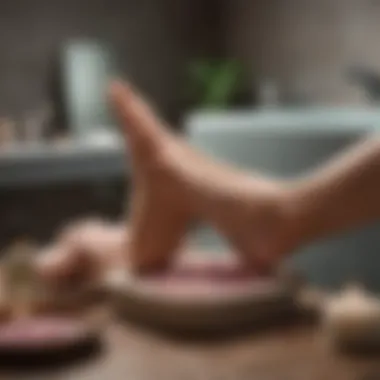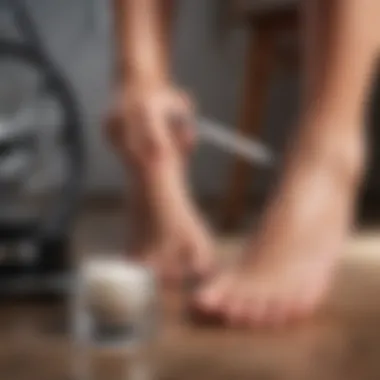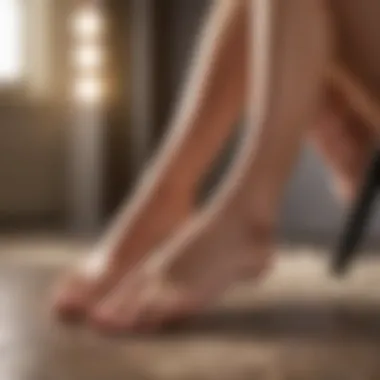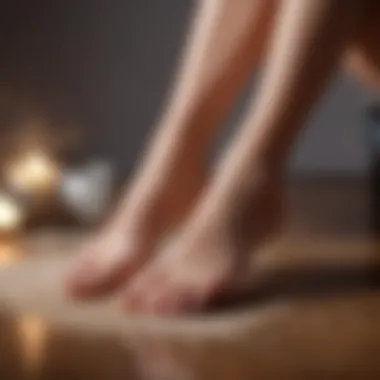The Comprehensive Guide to Home Feet Pedicures


Intro
In modern life, foot care often receives less attention than it deserves. Many view pedicures as a luxury reserved for salons, overlooking the potential of performing them at home. This guide serves as a practical resource for women who wish to elevate their foot care routine.
By understanding the techniques, tools, and products necessary for effective at-home pedicures, individuals can attain professional-quality results without visiting a salon. Regular maintenance can significantly improve foot health and overall well-being.
The guide covers common foot issues and provides a systematic approach to achieving the desired results. Additionally, it highlights the importance of making foot care a consistent part of one’s beauty regimen. In essence, this article aims to foster a deeper appreciation for foot care by exploring methods that enhance both the aesthetic and health benefits associated with well-maintained feet.
Prologue to Home Feet Pedicures
Home pedicures are an intrinsic part of personal foot care that often gets overlooked. Many people may associate pedicure treatments solely with visits to a salon, but the practice of caring for one’s feet at home comes with significant benefits. This introduction serves to emphasize the importance of incorporating pedicures into a regular self-care routine, particularly for women of all ages.
First, understanding the value of a home pedicure can empower individuals to take charge of their foot health. Regular foot care can prevent various issues such as dry skin, calluses, and even infections. A keen awareness of foot hygiene reflects a person’s overall commitment to their health and well-being.
Moreover, performing pedicures at home allows for a custom experience tailored to personal preferences. You can explore different products and techniques that suit your unique foot care needs. This level of personalization simply isn't achievable in a salon setting, where services are standardized.
The convenience aspect cannot be understated. Home pedicures save time and can be done on your own schedule, rather than adhering to salon hours. Therefore, it is possible to integrate foot care into daily routines seamlessly.
Economically, a home pedicure represents a sound investment. Over time, the costs associated with frequent salon visits can accumulate significantly. By investing in the right tools and products, you can enjoy professional-quality pampering without recurring expenses.
"Taking time for regular foot care promotes not only physical health but also enhances self-esteem and relaxation."
In this guide, readers will learn essential techniques, tools, and products required for an effective pedicure. Understanding the importance of a home pedicure lays the groundwork for the rest of the content, allowing individuals to appreciate and engage with their foot care practices more holistically.
Why Choose a Home Pedicure
Choosing a home pedicure can be a pivotal decision for many women looking to enhance their foot care routine. There are several elements that make home pedicures an attractive option. They offer numerous benefits that cater to both practical and personal preferences. In this section, we explore the reasons behind opting for a home pedicure and how it aligns with a modern lifestyle.
Cost-Effectiveness
One of the most compelling arguments for performing pedicures at home is cost-effectiveness. Salon treatments can add up quickly, especially when one wishes to maintain regular foot care. Let's consider some of the expenses involved with professional services:
- The average cost of a salon pedicure ranges between $35 to $60.
- Additional services, such as nail art or special treatments, further increase these costs.
- Traveling to and from a salon also adds an indirect expense.
By transitioning to a home pedicure, these costs can be significantly reduced. The initial investment in tools and products may seem high, but it pays off in the long run. Effective tools like foot files, nail clippers, and moisturizing creams can be used multiple times over months and years. This long-term savings is vital for those seeking to maintain their budgets while still engaging in self-care.
Convenience and Flexibility
Convenience is another significant factor favoring home pedicures. Women today lead busy lives, juggling work, family, and social commitments. Scheduling a salon appointment can feel like another burden. A home pedicure allows one to reclaim that time and flexibility. Here are some elements of convenience:
- No travel required: No need to commute to a salon, saving both time and energy.
- Flexible timing: You can choose to do your pedicure at your leisure. Whether it is early morning or late evening, the time is entirely yours.
- No pressure: At home, one can take their time. Unlike salon environments, where appointments are timed, you can enjoy the process at your own pace.
This shift not only enhances the pedicure experience but also allows for integration into one's daily routine without the added stress of appointment scheduling.
Personalized Experience
Every individual has unique preferences regarding foot care. A home pedicure provides the opportunity to tailor treatments to personal needs. Here are some examples of how personalization plays a key role:
- Custom product selection: You can choose products based on your skin type, nail condition, and scent preferences. Whether it is a particular brand of cuticle oil or a specific type of scrub, the choice is yours.
- Technique adaptations: Different people have different techniques they find soothing. At home, one can experiment with various methods until they discover the perfect routine.
- Ambiance control: Creating the right atmosphere is important for relaxation. At home, you can set up your space with calming music, dim lighting, or even scented candles that reflect your preferences.
In essence, home pedicures are not only about foot care but also an opportunity for self-expression and wellness.
"Investing in home pedicures is investing in both your health and your peace of mind."
Essential Tools and Products for a Home Pedicure
Performing a pedicure at home is not just about applying nail polish. It is a multifaceted process that requires the right tools and products to ensure both effectiveness and safety. Understanding the essentials can greatly enhance the experience and results of your home pedicure. Having the correct tools not only makes the process smoother but also contributes to healthier feet.


Basic Tools Overview
A well-equipped pedicure toolkit includes several fundamental tools:
- Nail Clippers: Essential for trimming toenails to the desired length.
- Nail Files: Used to shape the nails and prevent snags or breaks.
- Cuticle Pushers: These help in managing cuticles, keeping them neat and healthy.
- Pumice Stone or Foot File: For exfoliating dead skin and calluses on the feet.
- Foot Soak Bowl: Needed for soaking feet, essential for softening skin.
- Brush: Useful for removing dirt and dust from toenails and feet.
Each tool has a specific role, ensuring a comprehensive pedicure. Investing in high-quality tools can improve durability and efficiency. Also, it helps in avoiding injuries that may arise from using blunt or poor-quality tools.
Recommended Products
Apart from tools, there are various products that can enrich your pedicure experience. Here are some recommendations:
- Exfoliating Scrub: Look for scrubs that contain natural ingredients. They can aid in sloughing off dead skin, leaving feet smooth.
- Moisturizer or Foot Cream: A good moisturizer is vital for hydration. Creams with shea butter or coconut oil provide deep nourishment.
- Nail Polish and Top Coat: Choose nail polishes free from harmful chemicals. A quality top coat ensures shine and longevity for your manicure.
- Foot Masks: These can offer extra hydration and comfort, primarily targeting cracked heels or dry areas.
Utilizing effective products contributes significantly to the overall health of your feet.
Sanitization Practices
Maintaining hygiene during a home pedicure is crucial to prevent infections or complications. Here are some best practices:
- Clean Tools: Always disinfect tools before and after use. Alcohol wipes or antiseptic solutions are effective for this purpose.
- Wash Your Feet: Before starting the pedicure, wash your feet thoroughly to remove dirt and bacteria.
- Use Disposable Items: Where possible, use disposable files or cuticle pushers. This reduces the risk of cross-contamination.
- Keep the Area Clean: Ensure that the area you use for pedicures is clean and free from dust.
Following proper sanitization practices is paramount. It protects you and ensures that the tools work effectively without introducing additional risk.
"Investing in your foot care routine at home can lead to significant health benefits and a great presentation of your feet."
Step-by-Step Guide to Performing a Home Pedicure
A home pedicure can bring the luxury of a salon experience directly into your home. This section serves as a crucial roadmap for executing a successful pedicure. Particularly, understanding each step helps in achieving not only aesthetic appeal but also overall foot health. Structured guidance increases confidence, especially for those new to this practice. It empowers you to address specific needs of your feet, ensuring a well-rounded approach to foot care.
Preparation of the Feet
The first step in your home pedicure is to prepare the feet. This involves cleaning the feet thoroughly, removing any existing nail polish, and checking for any foot issues. Unsightly toe fungus or small cuts can interfere with your pedicure process. Therefore, it is advisable to address any underlying concerns before proceeding. Trim your toenails slightly, but avoid cutting them too short as this can cause pain.
Soaking Techniques
Soaking the feet is highly valuable. It softens the skin and prepares the nails for better exfoliation and care. Use a bowl filled with warm water, adding Epsom salt or a foot soak solution. Soak your feet for about 10 to 15 minutes. This step also promotes relaxation—a key component for a satisfactory experience. A warm compress can be used if you seek a quicker method but with less efficacy in softening the skin.
Exfoliation Methods
Exfoliation is essential for removing dead skin cells and calluses that can build up. Use a pumice stone or foot scrub to gently rub the heels and soles of your feet. Focus on rough areas but avoid excessive pressure which can cause discomfort. Furthermore, you can incorporate a foot scrub product that contains natural exfoliants like sugar or sea salt for added effectiveness. After exfoliation, rinse your feet thoroughly.
Nail Care and Shaping
Next, focus on nail care. After your feet are clean and exfoliated, use a nail clipper to shape your toenails appropriately. Cut straight across to prevent ingrown toenails. If needed, use a nail file to smooth any sharp edges. Applying a cuticle oil can help in softening the cuticles before pushing them back gently. This attention to detail gives your pedicure a more professional finish.
Moisturizing the Feet
Moisturizing is often overlooked, yet crucial in pedicure routines. Choose a rich foot cream or lotion suitable for your skin type. Massage the moisturizer into your feet, focusing particularly on dry areas. This not only nourishes your skin but also enhances circulation. After application, you may opt to wear cotton socks to help the moisturizer absorb more effectively.
Polishing and Finishing Touches
The final step involves applying polish to your toenails. Choose a quality nail polish that complements your style. Before applying, use a base coat to protect your nails. After the base, follow with two coats of your chosen color, finishing with a top coat for shine and durability. Allow enough time for your nails to dry completely. To finish, consider adding a few drops of nourishing oil on cuticles for a polished look.
A home pedicure, when done effectively, enhances both the appearance and health of your feet.
Common Foot Issues and Their Solutions
Understanding common foot issues is vital for maintaining healthy feet. These issues not only affect appearance but can also lead to discomfort and pain. Addressing these problems with effective solutions can enhance your foot care routine significantly. This section addresses three prevalent foot conditions that many women encounter: dry skin and calluses, ingrown nails, and fungal infections. Each subsection will provide insights into these issues and practical ways to manage them.


Dry Skin and Calluses
Dry skin on the feet can lead to a rough texture and calluses if not addressed properly. Calluses develop due to pressure and friction, often forming on the heels and balls of the feet. They serve as a protective barrier but can become painful.
To combat dry skin:
- Regular Exfoliation: Use a foot file or a pumice stone during your pedicure routine to remove dead skin. This helps to prevent callus buildup.
- Moisturization: Apply a heavy foot cream containing urea or glycerin after exfoliating. Daily moisturization is crucial, especially in dryer months.
- Avoid Hot Water: Soaking your feet in very hot water can exacerbate dryness. Instead, opt for warm water.
Addressing calluses can also involve more focused care:
- Salicylic Acid Pads: Over-the-counter treatments containing salicylic acid can soften calluses. Follow product instructions carefully.
- Consult a Podiatrist: If calluses become too painful or persistent, it may be wise to seek professional help.
Ingrown Nails
Ingrown nails occur when the edges of the nail grow into the surrounding skin, often causing pain, redness, and swelling. This condition is more common in the big toe.
To prevent and treat ingrown nails:
- Proper Nail Trimming: Always cut nails straight across. Avoid rounding the edges, which can promote the nail growing into the skin.
- Footwear Choices: Wear shoes that fit well and provide ample space for your toes. Tight footwear can increase the risk of ingrown nails.
- Warm Compresses: If you already have an ingrown nail, applying a warm compress can reduce discomfort. It’s essential to keep the area clean.
In more severe cases, or if the ingrown nail becomes infected, it is advisable to consult a healthcare professional for appropriate treatment.
Fungal Infections
Fungal infections such as athlete's foot or nail fungus are common foot problems that can lead to discomfort and unsightly appearance. These infections thrive in moist, warm environments, such as locker rooms or poorly ventilated footwear.
To prevent and manage fungal infections:
- Maintain Dryness: After washing your feet, ensure they are thoroughly dried, especially between the toes.
- Use Antifungal Powders: Applying antifungal powder can minimize moisture and help in preventing infections.
- Proper Footwear: Choose breathable shoes and moisture-wicking socks. Avoid wearing the same shoes every day to allow them to dry out.
- Consult a Doctor: If you suspect a fungal infection, seeking professional advice is necessary. Prescription treatments may be required for severe infections.
Addressing foot issues isn't just about aesthetics; it plays a critical role in overall foot health, preventing more significant problems down the line.
By recognizing and addressing these common foot concerns, women can enhance their self-care routine. With the right practices, dry skin, ingrown nails, and fungal infections can be managed effectively, leading to healthier feet.
Aftercare for Healthy Feet
Aftercare is essential for maintaining the health and appearance of your feet after a pedicure. Neglecting proper foot aftercare can lead to various issues, including dry skin, fungal infections, and ingrown toenails. A good aftercare routine extends the results of your pedicure and keeps your feet feeling fresh and revitalized. The aim here is not only to enhance the beauty of your feet but to also ensure their overall health.
Daily Foot Care Tips
Implementing a daily foot care routine is important for maintaining foot health. Here are several key practices:
- Wash your feet daily: Use mild soap and ensure to clean between the toes thoroughly. Drying your feet properly afterward is crucial to prevent fungal infections.
- Inspect your feet: Regularly check for any changes, like cuts or unusual growths. Catching issues early can prevent complications.
- Keep toenails trimmed: Regularly trimming your toenails helps prevent ingrown nails. Cut them straight across and avoid rounding the edges.
- Wear breathable socks: Choose socks made of cotton or moisture-wicking materials to help keep your feet dry and comfortable.
These habits form the foundation of effective foot care, contributing to healthier feet over time.
Hydration and Moisturization Practices
Hydration and moisturization are key components in foot aftercare. After a pedicure, feet may require replenishment to maintain smoothness.
- Use foot cream: Applying a rich moisturizer can help combat dryness. Focus on the heels and any rough patches. Look for creams with ingredients like shea butter or coconut oil for added moisture.
- Apply at night: For improved results, apply your foot cream before bed and use socks to lock in moisture.
- Drink plenty of water: Staying hydrated internally also impacts skin health, including that of your feet.
Keeping your feet well-hydrated can significantly transform their texture and appearance.
Choosing the Right Footwear
Selecting appropriate footwear is another crucial aspect of foot care after completing a pedicure. The right shoes can help avoid unnecessary pressure and provide ample support:


- Opt for comfort: Shoes with cushioning and arch support can prevent foot pain and discomfort. Avoid high heels or shoes that lead to friction and blisters.
- Consider foot type: Understand your foot shape and select shoes that fit well and accommodate any unique features, like high arches or wide toes.
- Change shoes regularly: Rotating your footwear can help reduce wear and tear and promote better foot health.
By ensuring you wear the right footwear, you can protect your feet from harm and enhance their overall condition.
Proper aftercare can greatly enhance the longevity of your pedicure and overall foot health.
Creating a Relaxing Pedicure Environment at Home
Creating a relaxing environment for a home pedicure is essential. It goes beyond merely having the tools and products. A serene atmosphere can enhance the overall experience, making it feel more luxurious and indulgent. Setting the right mood helps to relieve stress, enabling the individual to focus on self-care. This section will outline key elements needed to craft the perfect ambiance along with the benefits that come from doing so.
Ambiance and Decorations
The first step to ensuring a relaxing pedicure experience is the ambiance. This can be created through various elements in the environment. Here are some important considerations:
- Lighting: Soft, warm lighting can transform a space. Instead of bright overhead lights, consider using candles or dimmable lamps. This helps set a calming tone.
- Seating: Choose a comfortable chair or cushion where you can sit back. Ergonomics matter, especially if the pedicure takes time.
- Decor: Simple decorations like plants or soft fabrics add to the ambiance. A few decorative pieces might make the setting feel more inviting.
- Cleanliness: A tidy space promotes relaxation. Ensure that the area is clutter-free, creating a peaceful environment.
Incorporating these elements creates a personal retreat. It promotes a mindset ready for relaxation and pampering.
Utilizing Aromatherapy
Aromatherapy can be a powerful tool in enhancing your home pedicure experience. The right scents have the potential to calm the mind and soothe the body. Here are a few ways to effectively use aromatherapy:
- Essential Oils: Diffuse essential oils such as lavender or chamomile. These are known for their calming properties. A few drops in a diffuser can fill the room with a relaxing aroma.
- Soothing Soaks: Incorporate scented bath salts or oil into your foot soak. This not only enhances the soaking experience but also nourishes the skin.
- Candles: Light scented candles during the pedicure. Choose fragrances that are soft and not overwhelming.
Using aromatherapy is not just about pleasant scents. It involves creating an environment that enhances relaxation and enjoyment. The right aroma can significantly elevate your mood, making your home pedicure feel more like a pampering session.
Frequently Asked Questions About Home Pedicures
In any guide about home pedicures, addressing common questions is essential. This section offers clarity to those looking to enhance their foot care routine, aiming to demystify misconceptions and provide practical insights. Understanding these frequently asked questions can make the pedicure experience smoother and more enjoyable, helping readers to achieve better results at home.
How often should do a pedicure at home?
The frequency of home pedicures depends on individual needs, skin type, and lifestyle factors. Generally, most people can benefit from a pedicure every 2 to 4 weeks. Regular maintenance helps to keep skin soft and free from calluses. Also, it allows for better nail care, reducing the risk of issues like ingrown nails.
Factors influencing frequency include:
- Activity Level: Those who are often on their feet may need more frequent pedicures.
- Skin Condition: Individuals with dry skin or calluses might require bi-weekly attention.
- Personal Preference: Some may enjoy pampering their feet more often.
Can use normal nail polish for a pedicure?
Yes, normal nail polish is suitable for pedicures. However, there are some considerations to keep in mind. Regular polish may chip more easily than gel polish, but it is easier to apply and remove. Those who prefer a glossy, long-lasting finish might opt for gel or shellac options. Regardless of the type of polish, one should ensure:
- Proper Prep Work: Clean and buff nails before application.
- Quality Products: Use good-quality nail polish and top coat to enhance longevity.
What should do if cut my cuticle?
Cutting a cuticle can happen, even with careful handling. If this occurs, there are steps to minimize damage. The first step is to clean the area gently with mild soap and water. After that, apply an antiseptic to prevent infection. It is crucial to keep the area moisturized by using cuticle oil or healing creams. Avoid removing any loose skin until it heals.
In case of severe bleeding or signs of infection, seeking advice from a healthcare professional is recommended.
"Regularly addressing foot concerns can prevent more serious issues and keep your feet healthy and comfortable."
By understanding the answers to these common questions, readers can better prepare for their home pedicure experience, empowering them to maintain their foot health efficiently.
Closure
In summarizing the journey through home pedicures, it is essential to emphasize the multiple benefits that arise from this practice. Engaging in regular at-home foot care routines not only enhances aesthetic appeal but also promotes overall health and well-being. For women of various ages, mastering the art of pedicures can lead to improved comfort and confidence.
One key element to consider is cost-effectiveness. Salon visits can accumulate significant expenses over time, while performing pedicures at home not only saves money but also allows for a tailored approach. Women can choose products and techniques that suit their specific needs, leading to a more satisfying experience.
Furthermore, the convenience and flexibility of performing a pedicure at home cannot be overstated. There is no need to schedule appointments or travel, which can often be a burden. Instead, women are empowered to allocate time as fits their individual schedules. This flexibility encourages regular foot care, resulting in healthier feet.
Moreover, the personalized experience that comes from home pedicures allows for exploration and experimentation with different tools and products. Understanding your foot care preferences helps in establishing a routine that is most effective.
Maintaining a relaxing ambiance enhances the overall pedicure experience. By creating an oasis at home, women can look forward to their foot care rituals as methods of self-care and rejuvenation. The guide outlines various techniques and products to include in this practice, ensuring women are well-equipped to maintain their feet effectively.



